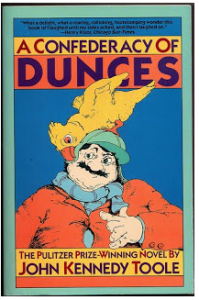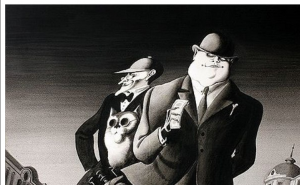SENSUAL IMPRESSIONS: NEW ORLEANS/MOSCOW
SENSUAL IMPRESSIONS: A Confederacy of Dunces/The Master and Margarita
My husband and I were 23 and 22 when we visited New Orleans two months before John Kennedy Toole’s March 26, 1969, suicide.
I remember a quaint room off a garden with a wrought iron fence, the smokey power of Nat and Canonball Adderley’s jazz, and the tinny horns of old men who played for tips in narrow spaces between the clubs. This year, when I first read Toole’s A Confederacy of Dunces, the impression of sensual overload came rushing back. New Orleans is a city that doesn’t let go.
In the book, Ignatius Reilly, age 31, an obese man whose taste runs to a flannel shirt and green deerstalker hat, lives with his mother and wants only to stay in bed and work on his novel. But circumstances demand that he get a job. He stumbles into several: a subversive file clerk in a clothing factory, hotdog vendor who eats all the wares from his cart, an unwitting courier for a pornography ring. Ignatius describes his true work this way: “I dust a bit…in addition, I am at the moment writing a lengthy indictment against our century. When my brain begins to reel from my literary labors, I make an occasional cheese dip.” While he works, his mother discovers bowling. Her friend, an Italian cop, searches for lawbreakers among the blacks, Jews, pornographers, gays, strippers, and tourists. Ignatius might be the one arrested, if he doesn’t worm his way out.
Though it was already written, no one was reading Dunces in 1969. Publishers and writers told Toole it was too amusing, too purposeless, and too long. All true, but yet impossible to forget.
After Toole’s suicide using a garden hose to bring fumes into his car, his mother launched a relentless campaign to get the book into print. In 1981 A Confederacy of Dunces won the Pulitzer Prize.
John Kennedy Toole was not yet two years old when Mikhail Bulgakov’s literary friends sat for a reading of The Master and Margarita, the story of the Devil’s visit to Moscow. The creative repression of Moscow would seem to have nothing in common with the exuberance of New Orleans. But the love Bulgakov evokes for Moscow is the same.
The Master and Margarita is a fantasy about the Devil’s visit to Moscow with his preposterous cat and his henchmen. “Right eye black, left—for some reason—green. Dark eyebrows, but one higher than the other. In short, a foreigner.” Grotesqueries coexist with realism and ethical concerns, exposing compromising intellectuals desperate to hang onto their clubs and theaters and special status, the posers who rush to claim an apartment before the deceased owner is taken out, the Master whose story of Pontius Pilate and Yeshua is dangerous in a country that’s steadfastly atheist, and Margarita who flies naked on a broomstick in order to find the Master who disappeared into a mental clinic. It takes the devil to make sense of it.
Like Dunces, The Master and Margarita is amusing—but it’s purposeful, too, exposing the chokehold of Soviet Communism on creative life. One character is surprised to find a clever man. “I must admit there are some smart people even among the intelligentsia.”
A heavily censored version of The Master and Margarita was published 27 years after Bulgakov’s death from liver disease. The first complete version appeared in Russian in 1973. Though five Soviet era authors have won the Nobel Prize, Bulgakov isn’t among them—yet.
Bulgakov’s sensual impression of Moscow makes that city as compelling as Toole’s New Orleans, putting both A Confederacy of Dunces and The Master and Margarita on my Top Ten list.
Sonia Linebaugh
Sonia L. Linebaugh is a freelance writer and artist. Her book At the Feet of Mother Meera: The Lessons of Silence goes straight to the heart of the Westerner’s dilemma: How can we live fully as both spiritual and material beings? Sonia has written three novels and numerous short stories. She’s a past president of Maryland Writers Association, and past editor of MWA’s Pen in Hand. Her recent artist’s book is “Where Did I Think I Was Going?,” a metaphorical journey in evocative images and text.

